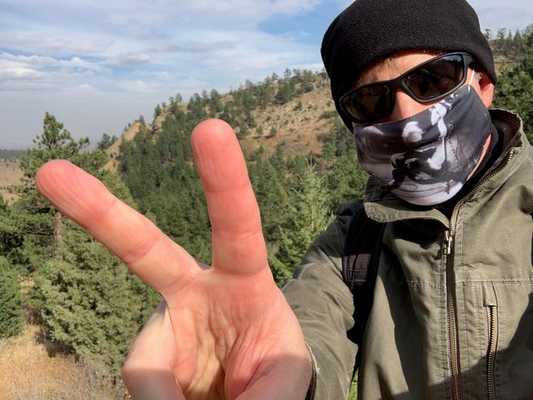
Christopher Smalley knows the public challenge of battling the COVID-19 pandemic only too well.
The former communications director for BID-Plymouth hospital spent weeks on end last spring working to keep the public informed about the disease and how best to navigate healthcare while staying safe.
So, when the Massachusetts resident and his wife recently traveled out west to visit with relatives in Colorado, he couldn’t help but notice an inconsistent response to the pandemic across much of the country and a lack in basic protective measures in states where the pandemic was surging.
“What was intriguing was that the populated areas were much more aware. The less populated were not paying too much attention,” Smalley said after completing an 11-day, 6,000-mile drive through 18 states. “Having lived it firsthand here from March through June was obviously challenging, and many states as we got farther west were still going through it.”
The Smalleys left their home in Massachusetts on Oct. 6 and traveled by Jeep through Connecticut, New York and New Jersey into Pennsylvania to start their ride west. People they encountered in New York and New Jersey, like those they saw in New England, generally had a responsible approach to the pandemic.
But from Pennsylvania on, Smalley noticed a more lax attitude about the virus and couldn’t help but look for the public health message from government officials and the healthcare industry along the way.
Through Maryland, the Virginias, Kentucky, Missouri and Kansas, into Colorado, on a side trip to New Mexico, and then back through the Nebraska, Illinois, Indiana and Ohio, Smalley saw people not following what he had come to know as the most basic rules for protecting against the disease.
In most parts of rural America, people do not wear masks, do not social distance, and do not limit their gatherings, Smalley said.
“Seeing all these responses was fascinating. Once we got to Pennsylvania, our first stop, it was very apparent to me that in New England, where we live, we’re doing a really, really good job,” said Smalley, who now works as a healthcare market analyst for Tesselatti, a North Shore advertising and marketing agency.
“Once we got to Pennsylvania, we saw more and more people coming and going without wearing masks and no one seeming to enforce it. It was a trend I witnessed as we went to Colorado, and on the way back a month later, the Midwest was surging.”
Looking back, what seemed to be missing was a lack of consistent messaging from the state, county, and local officials and even from the regional healthcare community. Smalley said it is possible that national politics played into regional decisions on how to respond to the virus. But he also thought the lack of government direction on state and regional levels might have been at play. He observed that states that had experienced shutdowns seemed to have a better attitude toward being careful about the disease.
He was struck by digital signs in New Mexico that, like similar signs on Massachusetts highways, urged people to stay home if they feel sick and follow proper health protocols. The signs weren’t as prevalent in the Midwest.
One simple message hit home for Smalley, who had worked in healthcare for the last 25 years. In the midst of a surge, it read “Protect Our Hospitals: Wear a Mask.” Smalley said the simple message was interesting to see, considering its importance amid so many people not wearing masks.
Smalley said he and his wife were especially cautious on their trip and always wore masks unless alone, social distanced and wiped down everything with disinfectants along the way. They prepared most meals out of their Jeep or in their hotel rooms, dining out only in more populated areas that had outdoor seating and where people seemed to be taking precautions seriously.
“We don’t want to go through this again. I’m not a scientist or a clinician, but I think the best way to avoid it is listen to what the public health officials say: wear a mask and social distance. I think it does make an impact,” Smalley said.
He acknowledged that even New England is seeing a rise in cases lately, but said it was not as bad as it was four or five months ago. “Unfortunately, the Midwest is really experiencing the challenges we did. I think if they had more consistent messaging, those numbers might not be as high as they are now,” Smalley said. “I do think there’s a huge opportunity to put the politics aside and listen to the public health experts and hopefully adhere to the message: wear masks, social distance, limit crowds.”
Accomplished communications and marketing leader with a track record of developing award-winning strategic communications and marketing campaigns, a collaborative leadership style, and strong commu... Read more